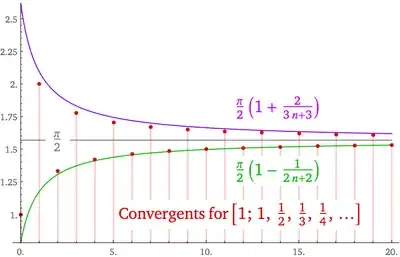The article shows that as the harmonic series $\sum\frac{1}{n}$ diverges, one can apply Van Vleck's theorem to show that the $2n$th and $(2n+1)$th convergents of the continued fraction $[1; 1, 1/2, 1/3,\dots]$ both exist and converge to the same limit.
The author transforms $[1;1,1/2,1/3,\dots]$ into the form
$$1+\frac{1\cdot1}{1+\frac{1\cdot2}{1+\frac{2\cdot3}{1+\dots}}}$$
by multiplying the numberator and the denominator of the $n$th fraction by $n$. Let $f_n$ be the numerator or the denominator of the $n$th (even) convergent then $f_n$ satisfies the relation
$$f_n=(2n^2-4n+3)f_{n-2}-(n-1)(n-2)^2(n-3)f_{n-4}$$
By direct substitutions, one can show that $A_n$ and $B_n$ where $A_n=\prod_{k\text{ even}}^nk^2$ and $B_n=(n+1)\prod_{k\text{ odd}}^{n-1}k^2$ satisfy the relation for even $n$s. The fraction $\frac{A_n}{B_n}$ has a limit known as the Wallis product. Since for odd $n$s the $n$th convergent converges to the same limit as previously proved, the continued fraction converges to $\frac{\pi}{2}$.
I hope this is a clear summary of the article that can save you some time. Sorry for falsely flagging your question.
Edit:
(1) If you are not familiar with the Van Vleck theorem, it is helpful to study the Seidel-Stern theorem. This theorem states that if $\sum b_n=\infty$ and $b_n$ positive, then $K(1/b_n)$ (the continued fraction) converges. The proof of this theorem can be found in Waadeland and Lorentzen's text Continued Fractions with Applications, Chapter 3 Theorem 3. The proof takes advantage of the fact that
$$\frac{A_{2n+1}}{B_{2n+1}}-\frac{A_{2n}}{B_{2n}}=\frac{1}{B_{2n}B_{2n+1}}\to 0$$
as $n\to\infty$. This can be seen from the recursive relation
$$B_{n}=b_nB_{n-1}+B_{n-2}$$
Since the $b_n$ are positive, we have $B_{2n}>B_{2n-2}>\cdots>B_0=1$ and $B_{2n+1}>\cdots>B_1=b_1$. Therefore
$$B_{2n}>b_{2n}b_1+B_{2n-1}>\cdots>(b_{2n}+b_{2n-2}+\cdots+b_2)b_1+1$$
and
$$B_{2n+1}>b_{2n+1}+B_{2n-1}>\cdots>b_{2n+1}+b_{2n-1}+\cdots+b_1$$
Since $\sum b_n$ divergese, the denominator goes to infinity with $n$.
Van Vleck's theorem, on the other hand, concerns the convergence of the continued fraction $K(a_n/b_n)$ with complex $a_n, b_n$. It gives a more general criterion for convergence according to the argument of $b_n$ and the divergence of $\sum |b_n|$ (in our case the argument is zero and $|b_n|=b_n$).
(2) The recursive relation is in no way magical. Let $f_n$ be the denominator or the numerator of the $n$th convergent, we have
$$f_n=b_nf_{n-1}+a_nf_{n-2}$$
$$f_{n-1}=b_{n-1}f_{n-2}+a_{n-1}f_{n-3}$$
$$f_{n-2}=b_{n-2}f_{n-3}+a_{n-2}f_{n-4}$$
like any continued fraction. Then $f_{n-3}=1/b_{n-2}(f_{n-2}-a_{n-2}f_{n-4})$. Plugging the second relation into the first one, one gets
$$f_n=(b_{n}b_{n-1}+a_n+a_{n-1}b_n/b_{n-2})f_{n-2}-a_{n-1}a_{n-2}b_n/b_{n-2}f_{n-4}$$
After the transformation we did, $b_i=1$ for all $i$ and $a_n=n(n-1)$ for $n>1$. Thus,
$$\begin{aligned}
f_n
&=(1+n(n-1)+(n-2)(n-1))f_{n-2}-(n-1)(n-2)^2(n-3)f_{n-4}\\
&=(2n^2-4n+3)f_{n-2}-(n-1)(n-2)^2(n-3)f_{n-4}
\end{aligned}$$
References:
Lorentzen, L. and Waadeland, H. (1992). Continued fractions with applications. Amsterdam ; London ; New York ; Tokyo: Elsevier Science Publishers B. V.
Pickett, T.J. and Coleman, A. (2008). Another Continued Fraction for π. The American Mathematical Monthly, 115(10), pp.930–933.
